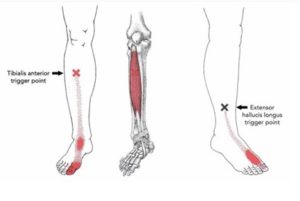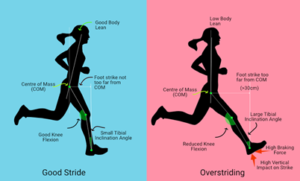What are shin splints?
 Shin splints are very easy to define and diagnose but are extremely misunderstood in terms of management and treatment. In the simplest terms, shin splints are characterized by pain and sometimes swelling of the muscles surrounding the shin. Specifically, the Tibialis Anterior muscle, but the Extensor Hallucis Longus and the Peroneus Longus muscles are also often involved. These muscles dorsiflex the foot. So, when you lift up your toes from a flat foot position these muscles contract. More importantly, they slow the foot’s heel to toe motion upon impact when walking or running.
Shin splints are very easy to define and diagnose but are extremely misunderstood in terms of management and treatment. In the simplest terms, shin splints are characterized by pain and sometimes swelling of the muscles surrounding the shin. Specifically, the Tibialis Anterior muscle, but the Extensor Hallucis Longus and the Peroneus Longus muscles are also often involved. These muscles dorsiflex the foot. So, when you lift up your toes from a flat foot position these muscles contract. More importantly, they slow the foot’s heel to toe motion upon impact when walking or running.
It is a muscle that can get inflamed from overuse and running is one of the main causes, as it is used extensively in the gait cycle. Trigger points in this muscle can produce local pain and even refer pain down into the foot and toes. This is really common in runners due to the repetitive stress on these tissues that comes with running high miles during the week. I often see this in other sports like lacrosse and soccer, especially towards the end of summer when the fields become a little harder and there isn’t quite as much cushion on the field. Now, what to do about them?
The 2 Opinions of Shin Splint Management… Rest + Suck It Up!
There is a group of people who say that shin splints are normal, that they are a part of running and they will go away eventually. The other group says they are scary, and you should not exercise for 4-6 weeks and hopefully they will feel better. Saying pain and dysfunction is a normal result of a sport is not something that we believe in at Core Chiropractic and Wellness. We believe that our athletes should continue to reach new goals and pain does not have to be a part of that.
Of course, the other option is to simply stop doing what you enjoy. I can not tell you how many patients have sat in our office on their first visit, tearfully considering stopping their running career upon the recommendation of their doctor or loved one. Our goal is to help our athletes regain a pain-free training program while increasing their longevity and performance. That rarely includes sitting or quitting. For shin splints, we would only recommend our patients stop their training in extreme circumstances such as compartment syndrome or stress fractures (these are very rare).
The real story is that there is something we can do about shin splints, without taking a break from running. Does that sound crazy? Keep reading…
Shin splints are always the result of a functional problem. Said another way, the patient’s brain is not choosing to utilize the muscles of the lower leg in the most efficient way. This creates tension in the muscular system, stiffness in the joints, and eventually pain or discomfort. Our goal with treatment is to enforce really good movement patterns with corrective exercise (Dynamic Neuromuscular Stabilization), eliminate the stiffness in the joints (Manipulation and Active Release Technique), and control the local inflammation with some passive modalities (Acupuncture, Dry Needling, Kinesiotaping, etc.). With these tools, we can make changes very quickly.
Treatment To The Next Level
 After we are able to control the pain and dysfunction, we will usually investigate the running mechanics. A really common flaw we see in running mechanics linked to shin splints is overstriding. In other words, the athlete is landing outside his or her base of support, which makes it very hard to distribute force throughout the entire leg, putting too much stress through the front of the leg. This technical issue can usually be solved pretty quickly with some mindful running or using a metronome to adjust the cadence of a runner.
After we are able to control the pain and dysfunction, we will usually investigate the running mechanics. A really common flaw we see in running mechanics linked to shin splints is overstriding. In other words, the athlete is landing outside his or her base of support, which makes it very hard to distribute force throughout the entire leg, putting too much stress through the front of the leg. This technical issue can usually be solved pretty quickly with some mindful running or using a metronome to adjust the cadence of a runner.
Another common misconception in regards to running is that your foot strike (forefoot, midfoot, or rearfoot) predisposes you to injury. However, the research has shown us this is far less important than the posture of the lower extremity during the gait cycle. You are just as likely to injure yourself with each of the above foot strikes. The foot strike position shows promise of being important when you run at or under a 6 minute/mile pace. When your pace is slower than that, the foot strike loses importance.
Ice, Heat, or Nothing?
Self-care for shin splints is pretty straight forward. A warm-up is key to beginning the training in order to increase blood flow to the muscles. This will decrease the residual tension in the lower leg muscles and improve the basic biomechanics of the running gait. After the run an Epsom salt bath followed by real ice cubes in a zip lock bag applied to the muscles can be very effective in reducing the tension and inflammation associated with shin splints.
Conclusion
Shin splints are a manageable condition that should not keep anyone sidelined for any length of time. Conservative care offers many resolutions to this painful condition when applied properly. At [Core], our goal is to see you reach your goals. We strive to provide the best treatment and education to see this become a reality. What can we help you achieve?

Daryl C. Rich, D.C., C.S.C.S.
This week 10% Off All CBD Products!






